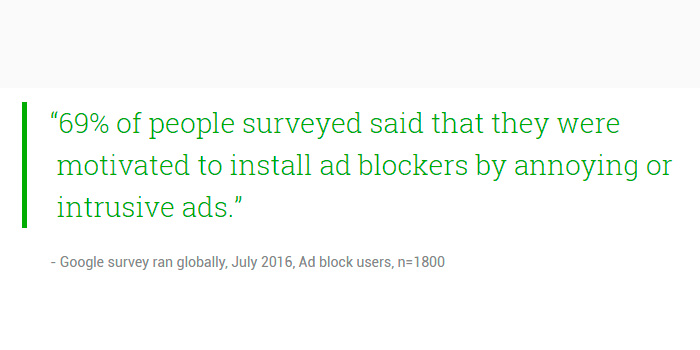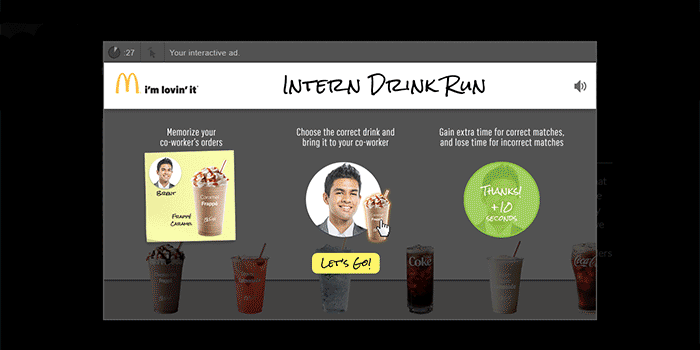Meet the new economy, where the consumer is both banker and buyer.
The currency of choice? Time and attention.
It’s an era where online display campaigns live and die by their ability to cash in on that time and attention. Advertisers are looking for new and improved models to replace the outdated interruptive models.
The buzz on the street (and cyberspace) is all about engagement and interactive production. Engagement marketing, engagement advertising – no matter how you approach it, it’s a consumer-centric model that recognizes people aren’t passively awaiting the next pop-up or pre-roll video ad.
And with the holidays around the corner, advertisers and publishers are looking for ways to incorporate interactive production into high impact units and ad formats that catch the eye and attention of busy consumers.
The question is, how do they go about it?
Build for viewability, not impressions

– Image Credit to DoubleClick Blog:
https://www.doubleclickbygoogle.com/articles/creating-better-ad-experiences
Consumer’s time and attention is worth more than ever, but many advertisers are still crafting their online display campaigns for impressions, not viewability. The result? A digital landscape where every nook and cranny, from desktop to mobile, is packed with ads.
But the increase in quantity hasn’t been matched by an increase in effectiveness. Ad blocking is on the rise and it’s costing the industry billions.
And we get it. The impressions model of online display campaigns focused on quantity (how many impressions a unit could rack up), rather than quality (how many of those impressions were from viable, interested people).
After years of metric driven creative, it’s difficult to let go of those feel-good impression numbers. Viewability-centered campaigns that focus on building the types of banner ads that people want to see – think high impact units like video and rich media ads – requires a focus on quality, not quantity.
Remember, even with these quality-centered ads, you still have access to metrics to will show you which units are performing the best.
It’s all about choice – DoubleClick Partner
Consumers are increasingly accustomed to on-demand experiences, from their entertainment and transportation to their shopping. The new on-demand ecosystem puts the user in control, and that expectation carries over to what they expect when interacting with any content channel on their devices.
Instead of fighting the new reality or piling on more ads to get user’s attention, forward-thinking advertisers have begun adjusting their online display campaigns and strategies to adapt to the evolving landscape.
That’s where interactive production comes in.
Interactive production is centered on display ad experiences that put the user back in control. It recognizes that people want choices. That’s why it focuses on online display campaigns that center on high impact units like gamified ads, quizzes and ‘build your own’ experiences.
These types of creative units typically enjoy longer user interaction rates and better brand recall.
Consider this clever gamified ad from trueX, promoting McDonald’s McCafe beverages. It’s playful and relevant – after all, who hasn’t announced they were making a quick run to get food, coffee, etc., only to be besieged by a flurry of requests to ‘pick something up for me’?
Most important of all, it invites interaction because of the user control embedded into the unit. Users relax, knowing they’re driving the ad experience, instead of being broadcast to, against their will.
Blend in and behave
Strange advice, considering online display campaigns and high impact units are about standing out (or at least making a quantifiable impression on viewers), but bear with us.
Putting the user back in control is just one piece of the engagement advertising puzzle. The next aspect is about respecting the user experience. That includes being part of the content, instead of a break (or interruption) to it.
As digital marketers, it’s easy to get caught up in our own marketing and metrics – Impressions are up but viewability is down! Ad blocker adoption is on the rise! Attention is at a premium! Must break through banner blindness!
We scour content channels, taking note of the high impact units that make an impression on us. Display advertising is part of our toolkit, our trade. It’s both art and science to us.
And sometimes that leads to the types of ads that are turning consumers off to display advertising.
The Coalition for Better Ads conducted a survey to determine the criteria for ad standards. A whopping 50% of users surveyed said they wouldn’t revisit or recommend pages with pop up ads.

Digital ad: Image Credit to Coalition for Better Ads: https://www.betterads.org/research/standardpaper/
Other ad formats that hijacked user control and choice were viewed with equal distaste.
Desktop Ads – Annoying Ranking

Banner ad – Image Credit to Coalition for Better Ads: https://www.betterads.org/research/standardpaper/

Dynamic Ads – Image Credit to Coalition for Better Ads: https://www.betterads.org/research/standardpaper/
While it’s true that attention is at a premium, the solution isn’t to pile more and more ads into the internet ecosystem.
Strive to build ads that are:
- Informative
- Relevant
- Interactive
- Fast-loading
- Tailored to the environment where they’re viewed
Follow these guidelines and you’ll be more than equipped to shine in the attention economy.






